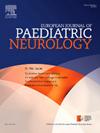伴有生发基质脑室内出血(GM-IVH)的早产儿癫痫发作:一项预测因素和神经发育结局的回顾性单中心研究
IF 2.3
3区 医学
Q3 CLINICAL NEUROLOGY
引用次数: 0
摘要
aimgerminal -matrix- ventricular hemorrhage (GM-IVH)是早产婴儿癫痫发作的主要原因。本研究旨在分析与癫痫发作相关的危险因素,并评估患有GM-IVH和癫痫发作的早产儿的神经发育结局。方法对2011年至2019年进行回顾性研究,通过电子患者档案系统识别2-4级GM-IVH早产儿。根据临床表现和异常脑电图诊断癫痫发作。婴儿按有无癫痫发作进行分组,并比较相关的合并症。神经发育随访在两岁时使用婴儿发育心理贝利量表II (BSID-II)进行评估。将癫痫发作婴儿的结局与2011年至2019年出生的所有出生体重为1500 g的早产儿(n = 195)进行比较。结果共纳入GM-IVH 2 ~ 4级早产儿34例。52.9%的病例发生癫痫发作。其发生与低胎龄(平均28.1周vs. 30周,p = 0.04)和肺炎(p = 0.003)显著相关。癫痫患儿的BSID-II心理评分(n = 15)明显低于无癫痫患儿(86.3±18.3比104.9±8.5,p = 0.03)。然而,由于这些婴儿的胎龄较低,我们无法区分他们的预后较差是因为癫痫发作还是因为不成熟。结论GM-IVH早产儿癫痫发作与低胎龄及肺炎有显著相关性。感染和炎症可能导致癫痫发作。需要更大规模的连续脑电图监测研究来验证这些发现。本文章由计算机程序翻译,如有差异,请以英文原文为准。

Seizures in preterm infants with germinal-matrix-intraventricular hemorrhage (GM-IVH): a retrospective monocentric study on predictors and neurodevelopmental outcome
Aim
Germinal-matrix-intraventricular hemorrhage (GM-IVH) is a leading cause of seizures in preterm infants. This study aimed to analyze risk factors associated with seizures and to evaluate neurodevelopmental outcomes in preterm infants with GM-IVH and seizures.
Methods
We conducted a retrospective study from 2011 to 2019, identifying preterm infants with GM-IVH grades 2–4 through an electronic patient file system. Seizures were diagnosed based on clinical manifestations and abnormal EEG findings. Infants were grouped by the presence or absence of seizures, and associated comorbidities were compared. Neurodevelopmental follow-up was assessed at two years of age using the Mental Bayley Scales of Infant Development II (BSID-II). Outcomes of infants with seizures were compared to all tested preterm infants with birth weight <1500 g born between 2011 and 2019 (n = 195).
Results
A total of 34 preterm infants with GM-IVH grades 2–4 were included. Seizures occurred in 52.9 % of cases. Their occurrence was significantly associated with lower gestational age (mean 28.1 vs. 30 weeks, p = 0.04) and pneumonia (p = 0.003). Infants with seizures had significantly lower BSID-II Mental scores (n = 15) compared to those without seizures (86.3 ± 18.3 vs. 104.9 ± 8.5, p = 0.03). However, as these infants had a lower gestational age, we could not distinguish if they had a poorer outcome because of seizures or because of immaturity.
Conclusion
Seizures in preterm infants with GM-IVH were significantly associated with lower gestational age and pneumonia. Infections and inflammation may contribute to seizure development. Larger studies with continuous EEG monitoring are needed to validate these findings.
求助全文
通过发布文献求助,成功后即可免费获取论文全文。
去求助
来源期刊
CiteScore
6.30
自引率
3.20%
发文量
115
审稿时长
81 days
期刊介绍:
The European Journal of Paediatric Neurology is the Official Journal of the European Paediatric Neurology Society, successor to the long-established European Federation of Child Neurology Societies.
Under the guidance of a prestigious International editorial board, this multi-disciplinary journal publishes exciting clinical and experimental research in this rapidly expanding field. High quality papers written by leading experts encompass all the major diseases including epilepsy, movement disorders, neuromuscular disorders, neurodegenerative disorders and intellectual disability.
Other exciting highlights include articles on brain imaging and neonatal neurology, and the publication of regularly updated tables relating to the main groups of disorders.

 求助内容:
求助内容: 应助结果提醒方式:
应助结果提醒方式:


